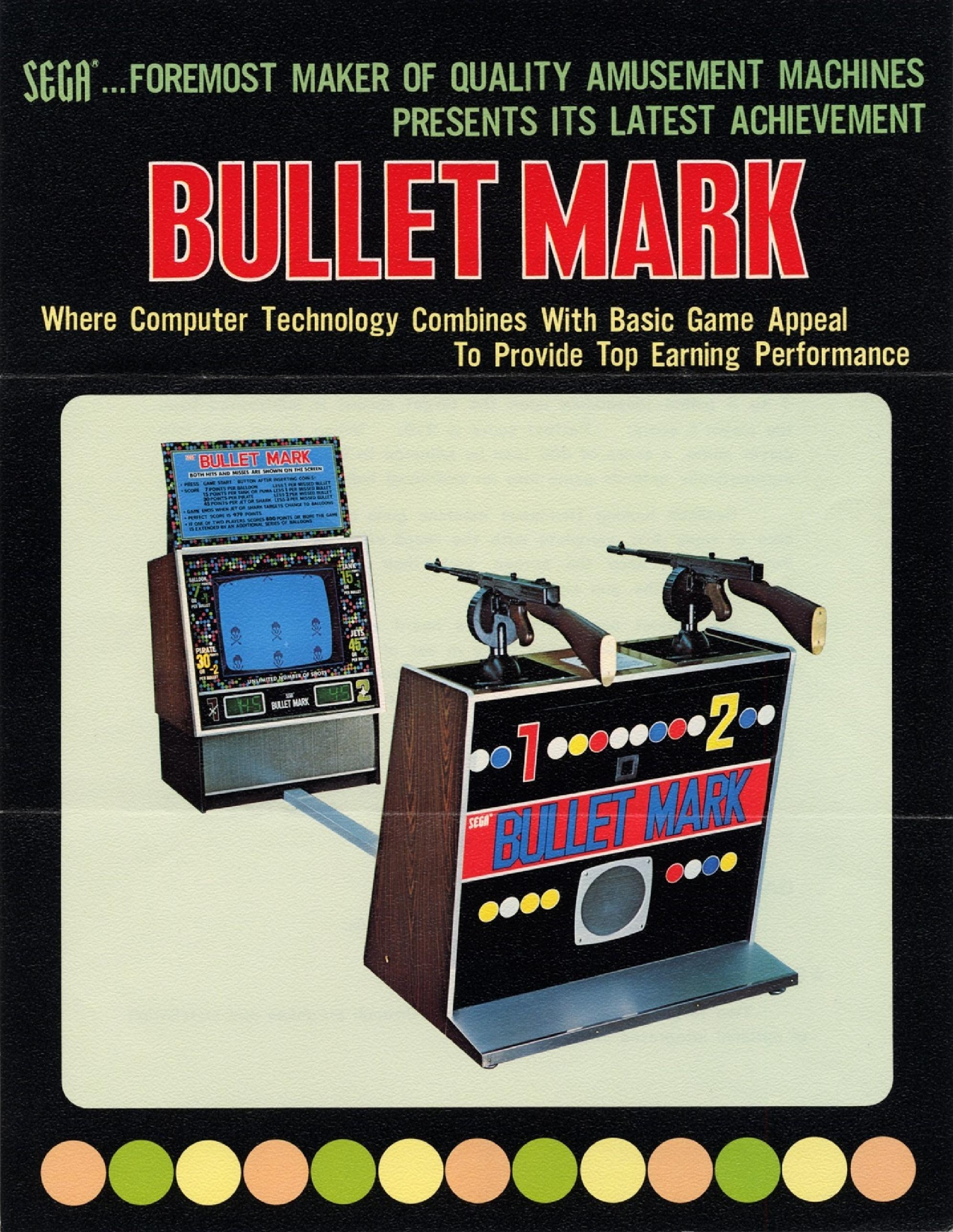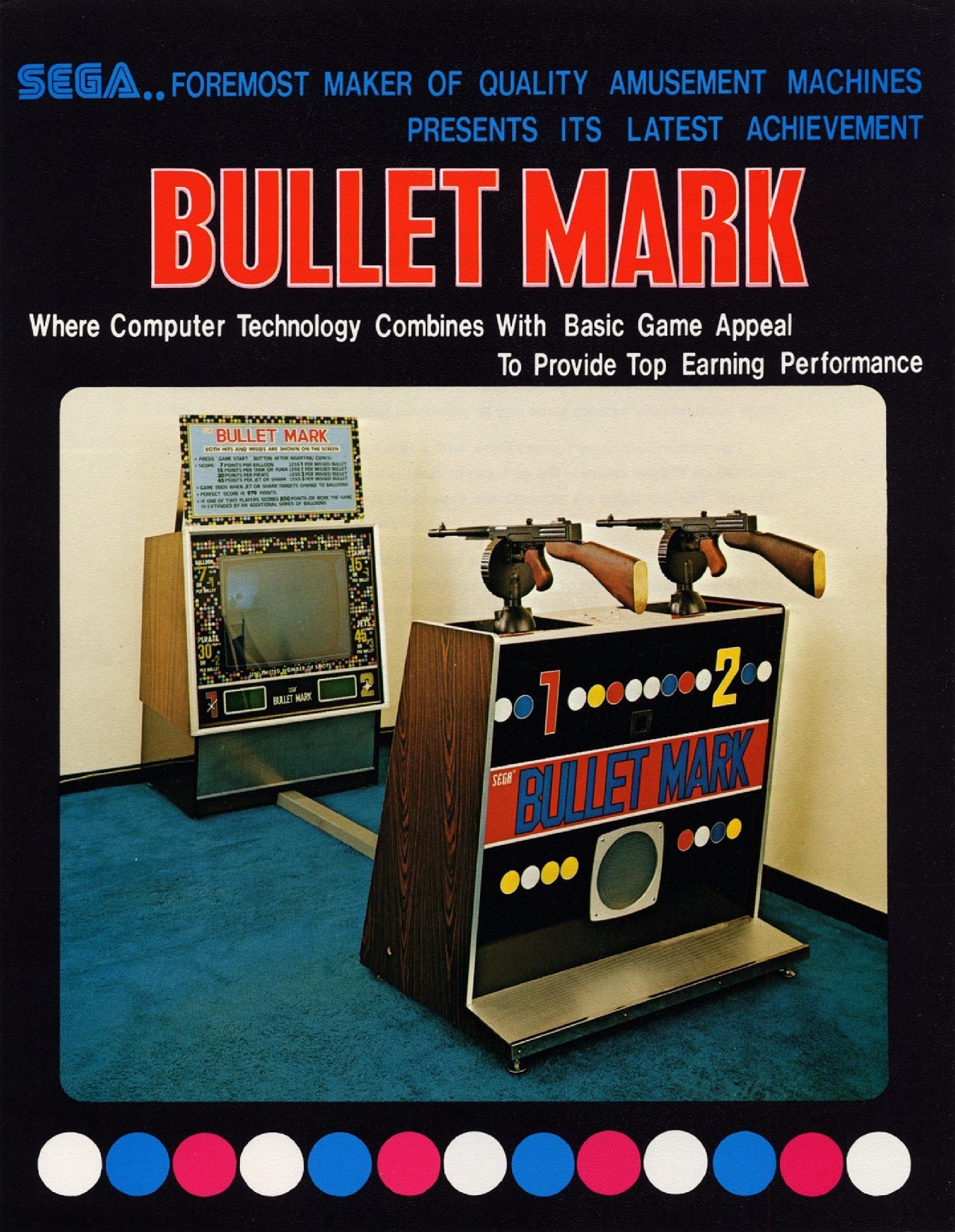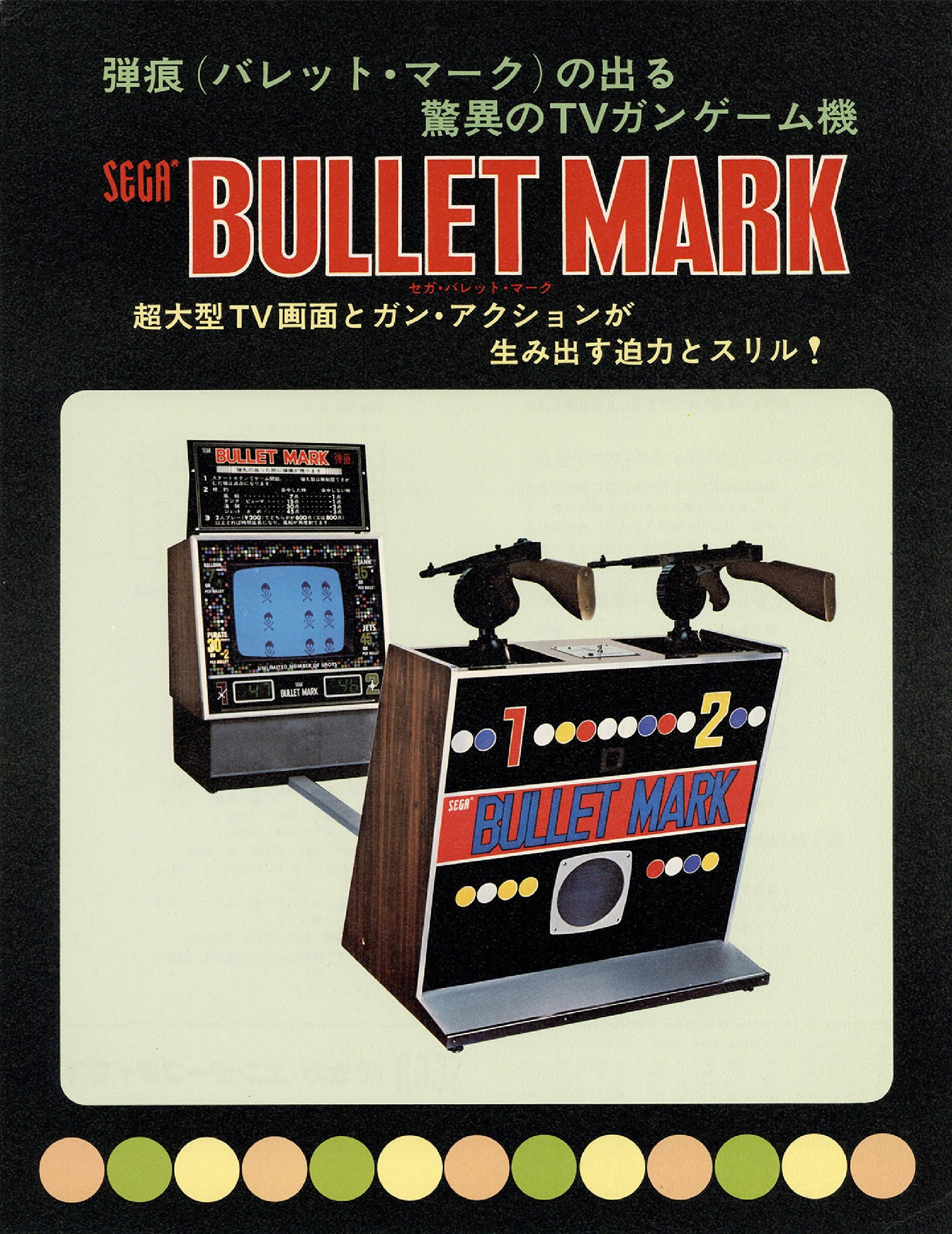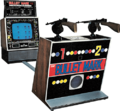Difference between revisions of "Bullet Mark"
From Sega Retro
Hyperspeed34 (talk | contribs) |
|||
| Line 19: | Line 19: | ||
{{sub-stub}}'''''{{PAGENAME}}''''' (バレットマーク) is a 1975 discrete logic game by Sega with twin Tommy Guns. It is similar to Sega's earlier 1974 game ''[[Balloon Gun]]'', but with a wider variety of targets to shoot. Like ''Balloon Gun'', it was a first-person light-gun shooter with two-player co-op gameplay. | {{sub-stub}}'''''{{PAGENAME}}''''' (バレットマーク) is a 1975 discrete logic game by Sega with twin Tommy Guns. It is similar to Sega's earlier 1974 game ''[[Balloon Gun]]'', but with a wider variety of targets to shoot. Like ''Balloon Gun'', it was a first-person light-gun shooter with two-player co-op gameplay. | ||
| − | ''Bullet Mark'' was Sega's first product to be manufactured in the United States,{{magref|cb|1975-11-29|51}}{{fileref|PlayMeter US Volume 01 No. 12.pdf|page=19}} being built at the [[Sega Enterprises, Inc.|Sega of America]] factory in Redondo Beach, California.{{magref|cb|1975-11-29|50}} In the United States, it sold 10 arcade units in 1975 and 200 arcade units in early 1976, for a total of 210 arcade units sold by early 1976.{{ref|https://archive.org/details/VideogamesInTheBeginningRalphH.Baer/page/n33/mode/2up}} | + | ''Bullet Mark'' was Sega's first product to be manufactured in the United States,{{magref|cb|1975-11-29|51}}{{fileref|PlayMeter US Volume 01 No. 12.pdf|page=19}} being built at the [[Sega Enterprises, Inc.|Sega of America]] factory in Redondo Beach, California.{{magref|cb|1975-11-29|50}} In the United States, it sold 10 arcade units in 1975 and 200 arcade units in early 1976, for a total of 210 arcade units sold by early 1976.{{ref|https://archive.org/details/VideogamesInTheBeginningRalphH.Baer/page/n33/mode/2up}} Due to its large size, it was a commercial failure in North America. Sega responded by developing a scaled-down version, ''[[Tracer]]'' (1976).{{ref|1=https://books.google.com/books?id=Cxy_DwAAQBAJ&pg=PT269}} |
==Gameplay== | ==Gameplay== | ||
Revision as of 08:32, 21 November 2024

| |||||||||||||||||

| |||||||||||||||||
| Bullet Mark | |||||||||||||||||
|---|---|---|---|---|---|---|---|---|---|---|---|---|---|---|---|---|---|
| System(s): Discrete logic arcade | |||||||||||||||||
| Publisher: Sega Enterprises, Inc. (US), Sega Enterprises, Ltd. (JP) | |||||||||||||||||
| Developer: Sega Enterprises, Inc.[1] | |||||||||||||||||
| Genre: Shoot-'em-up | |||||||||||||||||
| Number of players: 2 | |||||||||||||||||
|
This teeny-tiny article needs some work. You can help us by expanding it.
Bullet Mark (バレットマーク) is a 1975 discrete logic game by Sega with twin Tommy Guns. It is similar to Sega's earlier 1974 game Balloon Gun, but with a wider variety of targets to shoot. Like Balloon Gun, it was a first-person light-gun shooter with two-player co-op gameplay.
Bullet Mark was Sega's first product to be manufactured in the United States,[6][7] being built at the Sega of America factory in Redondo Beach, California.[1] In the United States, it sold 10 arcade units in 1975 and 200 arcade units in early 1976, for a total of 210 arcade units sold by early 1976.[8] Due to its large size, it was a commercial failure in North America. Sega responded by developing a scaled-down version, Tracer (1976).[9]
Contents
Gameplay
The guns have a recoil effect and can be fired as a single shot or in a short burst. Four series of targets appear sequentially on an oversized TV screen: balloons (worth 7 points), tanks (15 points), pirates (30 points) and aircraft (45 points). A perfect score is 979. Game time adjustable from 60 to 140 seconds. When played as a two-player game, a score of 800 (adjustable to 600 depending on the operator) by either player automatically extends the game into an additional balloon series.
Specifications
Dimensions
- Mass: 152kg
Promotional material
Physical scans
Photo gallery
References
- ↑ 1.0 1.1 1.2 Cash Box, "November 29, 1975" (US; 1975-11-29), page 50
- ↑ 1977 Sega Price List, page 5
- ↑ http://sega-interactive.co.jp/special/history/title/bulletmark.html (Wayback Machine: 2016-04-30 05:33)
- ↑ File:CashBox US 1978-03-25.pdf, page 76
- ↑ Amusement Trade Fair - Colour, British Movietone, February 8, 1976
- ↑ Cash Box, "November 29, 1975" (US; 1975-11-29), page 51
- ↑ File:PlayMeter US Volume 01 No. 12.pdf, page 19
- ↑ https://archive.org/details/VideogamesInTheBeginningRalphH.Baer/page/n33/mode/2up
- ↑ https://books.google.com/books?id=Cxy_DwAAQBAJ&pg=PT269








